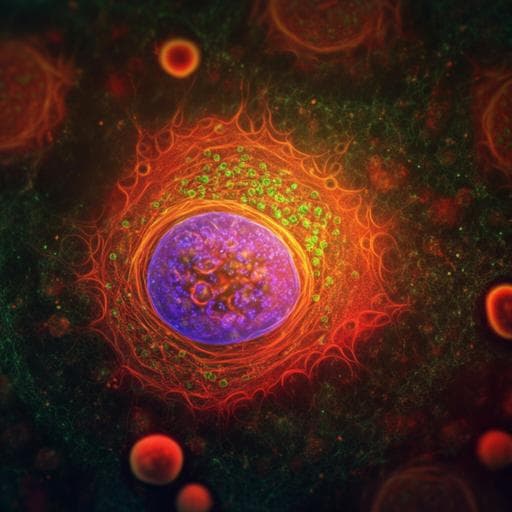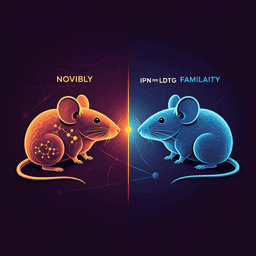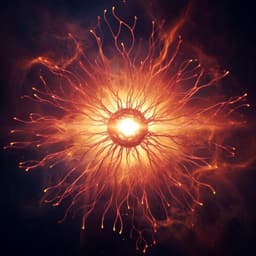
Biology
Optogenetic control of migration of contractile cells predicted by an active gel model
O. M. Drozdowski, F. Ziebert, et al.
This exciting research by Oliver M. Drozdowski, Falko Ziebert, and Ulrich S. Schwarz explores how optogenetics can control actin-driven cell migration by manipulating myosin contractility. The study reveals a bistability between sessile and motile states that opens new possibilities for understanding cellular behavior in response to light, with implications consistent with real-world neutrophil experiments.
~3 min • Beginner • English
Introduction
The study addresses how to control cell migration in contractile, crawling cells using optogenetic perturbations, focusing on the physical mechanisms that break front–back symmetry. While mesenchymal cell migration relies on actin polymerization at the front and myosin II contractility at the back, recent optogenetic experiments demonstrate that modulating contractility can induce polarization, reverse direction, or arrest motion in effectively one-dimensional settings (fibers, lines, channels). The key research questions are: whether an active gel framework centered on myosin contractility can predict bistability between motile and non-motile states; under what conditions optogenetic activation or inhibition of contractility can switch between these states; and how local versus global modulation of myosin affects migration control. The work is motivated by observations that contractile cells operate at intermediate tension, not saturation, enabling both up- and downregulation, and by the need to clarify the roles of local RhoA-mediated contractility gradients versus global myosin recruitment in setting and switching motility direction.
Literature Review
Active gel theory provides a natural framework to describe cytoskeletal flows and contractility-driven motility. Prior models have explored polarization-driven motion and adhesion stick–slip dynamics, often assuming saturated active stress at high motor concentration. However, experiments show contractility can be further increased by optogenetics, challenging saturation assumptions. Earlier active gel models sometimes treated myosins as an ideal gas; others predicted motility initiation/arrest and multistability, but without quantitatively linking optogenetic control to internal actin flows. Observations from optogenetic studies indicate cells can be driven into migration via local contractility changes (adhesion rupture on micropatterned lines) or via effectively global responses (e.g., to nuclear deformation). There remains ambiguity about how much control is achievable by local versus global contractility modulation and the extent to which actin polymerization alone can reorient motion in mesenchymal-like modes in confinement.
Methodology
The authors develop a one-dimensional active gel model for cells in microchannels. The constitutive relation assumes an infinitely compressible active gel with active stress proportional to local myosin II concentration c(x,t); viscous flow with shear viscosity and substrate friction mediates force balance. Cell length is variable with elastic boundary conditions representing volume homeostasis; front and back edges move with the local flow, and optional boundary polymerization velocities can be imposed to model actin polymerization.
A microscopic two-species model is introduced for bound myosin (advected with the gel) and unbound myosin (diffusing), with binding/unbinding/cooperative binding kinetics including excluded volume on actin and weak cooperativity (minifilament growth). Under local equilibrium, fast binding, and fast diffusion limits, this yields a single advection–diffusion equation for bound myosin with a nonlinear, concentration-dependent diffusion coefficient D(c). This D(c) exhibits slowdown at intermediate concentrations due to attraction and divergence at saturation due to excluded volume.
The same D(c) form is derived independently from linear irreversible thermodynamics for a supercritical van der Waals (vdW) fluid of myosins in solution, identifying the saturation concentration with excluded volume and the attraction parameter with an effective interaction energy.
Full model: combine active gel force balance, advection–diffusion for c with vdW-type D(c), and no-flux boundary conditions for c. Non-dimensionalization yields key parameters: adhesion/drag A (inverse Péclet), contractility P (motor stress scale), and a length ratio L. Parameter estimates from experiments give L≈1.25, P≈0.1, A≈1/77; vdW parameters chosen in a supercritical regime (e_c≈0.63, c_∞≈10).
Optogenetics is modeled as a spatiotemporal modulation of contractility P→P+εE(u,t), where ε is activation (positive) or inhibition (negative) strength within an activation region and time window; temporal response can be a plateauing function with rise/decay. Global myosin recruitment is implemented by a logistic source term increasing total c with rate R during illumination, effectively raising P and modifying vdW parameters. Actin polymerization is included via asymmetric boundary polymerization velocities that break symmetry.
Analysis and computation: steady-state bifurcation structure is studied via numerical continuation (AUTO07p) to locate pitchfork and saddle-node bifurcations and map regimes (sessile, bistable, motile) in (A,P). Time-dependent behavior is simulated using a discontinuous Galerkin finite element method (FEniCS) with appropriate schemes for heterogeneous diffusion and advection; time stepping is implicit/explicit as needed. Parameter sweeps examine initiation times, dependence on ε/P and A, inhibitory protocols (vary ε and duration), recruitment rates R, and polymerization switching thresholds.
Key Findings
- Nonlinear myosin diffusion arising from excluded volume and weak attraction (vdW fluid) induces bistability between sessile and motile states for experimentally realistic parameters when adhesion and contractility are balanced. Pure excluded volume (Tonks gas) does not yield bistability; at least a quadratic contribution in D(c) is needed to slow diffusion and enable it.
- Bifurcation structure: the transition from sessile to motile can become subcritical (bistable) near a critical attraction level; increasing attraction lowers the motility threshold.
- Parameter regime: using L≈1.25, P≈0.1, A≈1/77 (Pe≈77), and vdW parameters e_c≈0.63, c_∞≈10, the model predicts moderate myosin enrichment at the rear consistent with experiments, avoiding unrealistically sharp peaks seen in linear-diffusion models.
- Optogenetic switching:
• Local activation at the front or local inhibition at the rear can reverse migration direction and reproduce experimental kymographs; length decreases with activation and increases transiently with inhibition, with velocity changes building during the stimulus and relaxing after turn-off.
• Motility initiation from the sessile state is possible with small, localized activation strengths as low as ε/P≈1.2% (example threshold), while stronger perturbations accelerate initiation.
• Motility arrest or reorientation from a motile state requires larger ε than initiation because advection must be overcome; arrest depends on turning off activation within the resymmetrized basin, otherwise reorientation occurs.
- Initiation times:
• The time to reach steady motile velocity t_ini decreases with larger ε/P and scales asymptotically as t_ini∼(ε/P)^{-1}.
• Stronger adhesion (larger A) increases both the minimal activation ε/P required for initiation and t_ini.
- Inhibitory protocols reproduce experimentally observed response classes: weak response (velocity remains positive), transient reversal, and full arrest/reorientation. Strong inhibition ε≈−0.09 over Δt_inh≈63–126 s produces robust negative velocities and arrest; shorter or weaker inhibition yields partial responses. A characteristic velocity dip after turn-off arises from relaxation of contractility.
- Global myosin recruitment robustly initiates motility from the sessile state even with small recruitment rates (e.g., R≤0.2) if activation is long enough to raise P beyond the threshold; however, reorientation or arrest of a motile cell via global recruitment is difficult at realistic R, requiring very localized activation regions and unrealistically high rates (e.g., R≈4) to outpace advection of motors to the rear. Global recruitment generally decreases length due to increased P and is not well-suited for direction control.
- Actin polymerization switching at the boundary can in principle reorient motion, but only above a relatively large reversed polymerization velocity threshold (critical v≈−0.04 in nondimensional units, comparable to motile-state velocities). Below threshold, only slight broadening of the myosin layer occurs without reorientation. The model does not exhibit the experimentally observed velocity overshoot under polymerization-only switching, highlighting the central role of contractility changes.
- Overall, localized, reversible increases/decreases of contractility enable full, versatile control of migration state and direction, while global recruitment primarily serves as a robust mechanism for motility initiation by destabilizing the sessile state.
Discussion
The model quantitatively links optogenetic modulation of myosin II contractility to internal actin flows and cell migration control in one-dimensional confinement. By incorporating vdW-based nonlinear diffusion for myosin (capturing crowding and minifilament aggregation), the theory explains the emergence of bistability between sessile and motile states and predicts precise thresholds and time scales for switching. These findings address how contractility alone can control migration without invoking adhesion changes and reconcile experimental observations that both local RhoA activation and global myosin recruitment can initiate movement. The analysis clarifies roles: local contractility changes provide direction control and full controllability (initiation, arrest, reversal), while global recruitment robustly triggers initiation but is ill-suited for reorientation at realistic recruitment rates. The predicted initiation time scaling and inhibition-response classes match experimental trends, though absolute time scales may be underestimated if effective diffusion is larger in vivo. The results underscore contractility as the dominant control lever in mesenchymal-like migration in microchannels; actin polymerization changes can assist but require strong perturbations. This framework offers predictive guidance for designing optogenetic protocols and for engineering synthetic motile systems.
Conclusion
This work introduces a minimal active gel model with vdW-type nonlinear myosin diffusion that predicts and explains optogenetic control of migration in contractile cells. Key contributions include: (1) derivation and validation of a concentration-dependent diffusion coefficient from microscopic myosin binding kinetics and vdW thermodynamics; (2) demonstration of adhesion–contractility-controlled bistability enabling switching; (3) quantitative predictions for activation/inhibition strengths and initiation times; (4) clarification of the distinct capabilities of local contractility modulation (full control) versus global myosin recruitment (robust initiation); and (5) assessment of polymerization-driven reorientation showing high thresholds. Future research directions include: integrating adhesion stick–slip dynamics into the continuum framework; coupling to detailed signaling networks (RhoA/Rac/Cdc42) for combined biochemical–mechanical repolarization; refining long-time recruitment and homeostatic saturation behaviors; and extending to higher-dimensional geometries and diverse cell types.
Limitations
- Adhesion is treated via uniform friction without heterogeneous or stick–slip dynamics; thus predictions best apply to microchannel conditions where adhesion changes are secondary.
- One-dimensional geometry simplifies cell mechanics and ignores lateral effects present in 2D/3D.
- Parameters (e.g., vdW attraction, saturation concentration) are estimated; supercritical vdW assumption and weak cooperativity are chosen to match bistability and may vary between cell types.
- Time scales depend on the effective diffusion coefficient; if intracellular transport is faster, predicted dynamics could be slower than observed.
- Recruitment implementation is simplified (logistic source with saturation at c_∞); very long activations or complex homeostasis are not captured.
- Polymerization effects are imposed via boundary velocities without detailed filament dynamics or feedback with contractility.
Related Publications
Explore these studies to deepen your understanding of the subject.







